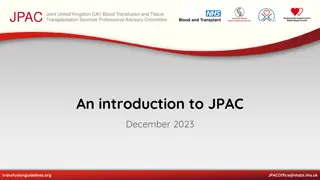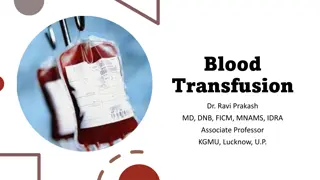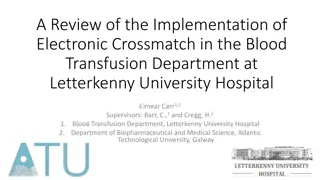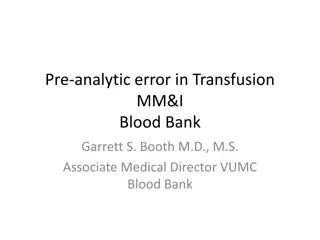Transfusion
Blood transfusion is a crucial medical procedure worldwide, with various components like packed red blood cells, plasma, platelets, and cryoprecipitate being utilized for efficient use. Differential centrifugation is employed for component preparation, ensuring precise separation of red blood cells,
2 views • 45 slides
Importance of Single Unit Red Blood Cell Transfusion According to Patient Blood Management Guidelines
Implementing single unit red blood cell transfusion based on patient blood management guidelines is crucial to minimize risks associated with transfusion, such as morbidity, mortality, and length of stay. By following these guidelines, healthcare providers can make informed decisions, reduce unneces
4 views • 18 slides
Understanding How Diabetes Affects Blood Vessels
Diabetes can harm blood vessels, leading to complications due to high blood sugar levels. Hemoglobin A1c plays a crucial role in monitoring glucose control, with values above 6.5% indicating diabetes. Over time, high blood sugars can damage blood vessels, affecting blood flow and increasing the risk
1 views • 19 slides
Understanding Red Blood Cell (RBC) Count and Its Significance in Blood Health
Red blood cells, comprising nearly 45% of blood volume, play a crucial role in oxygen transport. The red blood cell count, measured as the number of cells per unit volume of blood, helps assess the adequacy of oxygen-carrying capacity. Normal values vary by age and gender. The experiment aims to det
8 views • 16 slides
Overview of Serious Adverse Reactions and Transfusion Events
This data compilation covers the reporting trends, breakdown of reports, components issued, and specific types of adverse transfusion reactions experienced within the National Healthcare Organization (NHO) from 2019 to 2022. The information includes statistics on Serious Adverse Events (SAE), Seriou
2 views • 46 slides
Understanding the Components of Blood for Better Health
Explore the main components of blood such as red blood cells, white blood cells, platelets, and plasma. Learn how these components function, their percentages in blood, and how they impact human health. Discover the importance of blood donation and how changes in blood composition can affect overall
2 views • 19 slides
Understanding Blood Groups and Their Significance
Human blood types are determined by specific antigens and antibodies present on red blood cells, influencing crucial aspects like blood transfusions and familial relationships in forensic medicine. The ABO system, with its four main blood types (A, B, AB, O), plays a vital role in categorizing blood
7 views • 14 slides
Overview of JPAC: United Kingdom Blood Transfusion and Tissue Transplantation Services
JPAC, the Joint United Kingdom (UK) Blood Transfusion and Tissue Transplantation Services Professional Advisory Committee, plays a crucial role in providing guidelines and ensuring standardization and safety in the field of blood transfusion. Established in the late 1980s, JPAC has evolved to become
1 views • 33 slides
Understanding Blood Transfusion: Components, Preparation, and Safety Measures
Blood transfusion is a crucial medical procedure involving the transfusion of different blood components to patients in need. This practice has evolved to include various components such as packed red blood cells, plasma, platelets, and more. The preparation of these components involves specific tec
1 views • 45 slides
Understanding Non-Transfusion-Dependent Thalassemia
Delve into the complexities of Non-Transfusion-Dependent Thalassemia as explained by Dr. Ashutosh Lal, MD, from the Northern California Thalassemia Center at UCSF Benioff Children's Hospital Oakland. Explore the various Thalassemia syndromes, patient profiles, causes, and transfusion requirements as
1 views • 25 slides
Difference Between Massive Transfusion Protocol (MTP) and Emergency Release of Blood Products
Both MTP and emergency release are protocols for immediate blood product release without needing a type/screen. However, MTP involves fixed product dispensing, while emergency release allows customization. MTP requires contacting the blood bank to activate or deactivate, while emergency release requ
0 views • 6 slides
Understanding Shock and Blood Transfusion in Surgery
Shock is a state of low tissue perfusion leading to metabolic changes like anaerobic metabolism and acidosis. As cellular hypoxia progresses, immune and coagulation responses are activated, impacting cardiovascular, respiratory, renal, and endocrine systems. Shock can be classified into hypovolaemic
0 views • 38 slides
Understanding Blood Cells and Transport Mechanisms
Your blood, consisting of red blood cells, white blood cells, platelets, and plasma, plays a crucial role in transporting substances like oxygen, nutrients, and waste products throughout your body. Red blood cells are specialized for oxygen transport due to their unique adaptations, while white bloo
2 views • 18 slides
Implementation of Electronic Crossmatch in Blood Transfusion at Letterkenny University Hospital
This review explores the implementation of Electronic Crossmatch (EXM) in the Blood Transfusion Department at Letterkenny University Hospital. It discusses pretransfusion testing, crossmatching techniques, benefits, and challenges of EXM. The study aims to assess the benefits of EXM and identify way
0 views • 23 slides
Autologous Blood Donation: Advantages, Types, and Considerations
Autologous blood donation involves collecting and storing a patient's own blood for later transfusion, offering numerous advantages such as reducing the risk of transfusion-transmitted diseases and providing compatible blood for patients with allo-antibodies. However, it also comes with concerns lik
1 views • 46 slides
Rational Use of Blood and Blood Administration
Rational use and administration of blood components are essential in modern healthcare to save lives and improve health. Blood transfusion carries potential risks and should be prescribed only for conditions with significant potential for morbidity or mortality that cannot be managed effectively by
0 views • 53 slides
Ensuring Patient Safety in Blood Transfusion Services: Standards and Concerns
Hospitals providing Transfusion Medicine services must adhere to established standards to ensure patient safety and product efficacy. Facilities not carrying a laboratory license but receiving blood components must also meet these standards. Lack of standardized policies poses risks to patient safet
0 views • 20 slides
Understanding ABO Blood Grouping and Rh Groups
ABO blood grouping and Rh factor testing are crucial for blood transfusions and forensic medicine. The presence or absence of specific antigens and antibodies in human blood determines blood type. Genetic inheritance from parents establishes blood type, with codominance influencing offspring phenoty
0 views • 13 slides
Bloody Easy Blood Administration (BEBA) Guidelines for Transfusionists
This comprehensive guide provides transfusionists with essential information on blood administration, including transfusion guidelines for RBC, platelet, and plasma, actions for safe administration, and immediate management of transfusion reactions. It covers indications, doses, and details for adul
0 views • 49 slides
Understanding Blood Components and Their Administration
Effective blood transfusion therapy relies on the availability and proper administration of various blood components. Separating blood components allows for better patient care by matching transfusions to individual needs and avoiding unnecessary components. Different blood products like packed red
1 views • 27 slides
International Hemovigilance: Current Trends and Insights
Explore the latest trends in international hemovigilance from presentations by experts like Dr. Pierre Robillard. Gain insights on incidence rates of adverse transfusion reactions, transfusion-related deaths, and global initiatives on defining reactions. Dive into data from various reporting systems
0 views • 30 slides
Challenges Faced in Delivering Transfusion Education During a Pandemic
In the midst of the pandemic, the delivery of transfusion education faced significant challenges. Transfusion Practitioner Liz Park from Swansea Bay UHB navigated through the obstacles, adapting the education process from in-person sessions to a virtual environment. The year 2020 marked the beginnin
0 views • 7 slides
Understanding Antibody Screening and Pre-Transfusion Tests
In-house cell panel development, pre-transfusion compatibility testing, antibody screening methods, and the importance of ABO and Rh typing are discussed in detail. Steps for safe blood transfusion, reverse ABO grouping, AST testing for irregular antibodies, and selection criteria for screen cells i
0 views • 28 slides
Blood Transfusion Process and Implications Studied
Analyzing case studies of patients with different medical histories undergoing blood transfusions, this study examines the implications and adverse events associated with the process. It explores the use of blood transfusions in improving patient outcomes, challenges in managing hemoglobin levels, a
0 views • 31 slides
Versiti Blood Center of Illinois: Community Impact through Blood Drives
Versiti Blood Center of Illinois, a nonprofit organization, plays a vital role in healthcare by organizing blood drives to ensure a sufficient supply of blood for hospitals in the Chicagoland and Northwest Indiana area. Through employee engagement, community outreach, and raising awareness about the
0 views • 10 slides
Blood Management and Conservation Strategies in Pandemic Times
Explore the rationality behind patient blood management, the importance of audit in ensuring proper blood usage, and the role of national oversight groups in promoting safe and appropriate transfusion practices. Discover guidance, safety standards, and the use of O.D. negative red cells in emergency
0 views • 13 slides
Understanding Intravenous Fluid Resuscitation and Blood Transfusion in Clinical Practice
Intravenous fluid resuscitation and blood transfusion are crucial components of patient care, involving the direct administration of fluids and electrolytes to maintain proper fluid balance. When calculating the volume of fluid to be replaced, various factors must be considered, including maintenanc
0 views • 15 slides
Blood Transfusion Services Role in Massive Transfusion Events
Blood Transfusion Services play a crucial role in assisting with patient care during massive transfusion events. From notification to preparation of components and ongoing support, BTS staff ensure timely and appropriate transfusions, especially during emergencies. Communication with medical staff,
0 views • 6 slides
Understanding Complete Blood Count (CBC) Test
Complete Blood Count (CBC) is a panel of tests that evaluates different types of blood cells, including red blood cells, white blood cells, and platelets. CBC helps diagnose various blood disorders and monitor conditions that affect blood cells, such as anemia or infections. The test is ordered base
0 views • 20 slides
Hospital Transfusion IT Guidelines - Overview and Updates
Comprehensive guidelines for Hospital Transfusion IT systems by Julie Staves, Transfusion Lab Manager at Oxford University Hospitals Foundation Trust. Explains the need for guidelines in ensuring patient safety, the structure of the guideline, recent changes, and new developments. Covers essential t
0 views • 18 slides
Understanding the Basics of Blood and Transfusions
Blood is a vital tissue that performs essential functions like delivering oxygen and nutrients, maintaining immunity, and controlling body temperature. Blood transfusions save lives by treating accident victims, transplant recipients, cancer patients, and those with blood-related diseases. Component
0 views • 20 slides
Blood Transfusion in Surgery: Types and Indications
Blood transfusion plays a crucial role in surgery, with different blood products such as whole blood, packed red cells, fresh-frozen plasma, cryoprecipitate, and platelets being used based on specific needs. Understanding the indications and proper handling of blood products is essential for safe tr
0 views • 13 slides
Overview of Blood and Hematology: Functions and Composition
The human body consists mostly of water, with blood making up approximately 8% of body weight. Blood is composed of plasma and formed elements, including red blood cells (erythrocytes), white blood cells (leukocytes), and platelets. Plasma, the liquid part of blood, contains various proteins such as
0 views • 12 slides
Enhancing Blood Transfusion Safety in Primary Care: Key Updates for Healthcare Providers
Blood transfusion safety is a critical aspect of healthcare delivery, with the potential for preventable errors posing risks to patients. Initiatives like the Serious Hazards of Transfusion (SHOT) program and Patient Blood Management have played significant roles in improving safety and reducing adv
0 views • 25 slides
Understanding Blood: Composition and Functions
Blood is a vital fluid tissue in the human body, classified as a connective tissue. It consists of living cells known as formed elements suspended in a non-living matrix called plasma. The physical characteristics of blood, such as color range, pH level, and temperature, play crucial roles in mainta
0 views • 33 slides
Comprehensive Guide to Blood Collection Techniques in Medical Investigations
Blood collection is a crucial process in medical investigations where blood is withdrawn from patients for analysis. Methods include arterial sampling, venipuncture, and fingerstick sampling, each serving specific purposes. Venous blood is preferred over arterial blood due to accessibility and ease
0 views • 10 slides
Rational Use of Blood and Blood Components in Healthcare
Rational use of blood and blood components is crucial in healthcare settings to maximize resources, minimize risks, and enhance patient outcomes. This involves avoiding unnecessary transfusions, understanding the risks associated with transfusions, dispelling misconceptions, and choosing the most ap
0 views • 32 slides
Pre-Analytic Errors in Transfusion Process at VUMC Blood Bank
The case study discusses a 16-year-old female involved in a motor vehicle collision needing emergent transfusion support at Vanderbilt University Medical Center. Issues such as mixed field identification and blood type discrepancies were encountered, leading to the importance of using universal dono
0 views • 23 slides
Understanding Blood Group and Cross Matching in Transfusion Medicine
Blood group and cross matching play crucial roles in determining blood compatibility for transfusion. The presence or absence of specific antigens on red blood cells, along with antibody reactions, help identify blood types and ensure safe transfusions. Cross matching involves testing donor and reci
0 views • 8 slides
Understanding Complete Blood Count (CBC) Testing
Complete Blood Count (CBC) is a crucial test that provides information about the composition of a patient's blood, including red blood cells, white blood cells, and platelets. This test helps in diagnosing conditions such as anemia, infections, and more. CBC involves analyzing parameters like RBC co
0 views • 20 slides







































